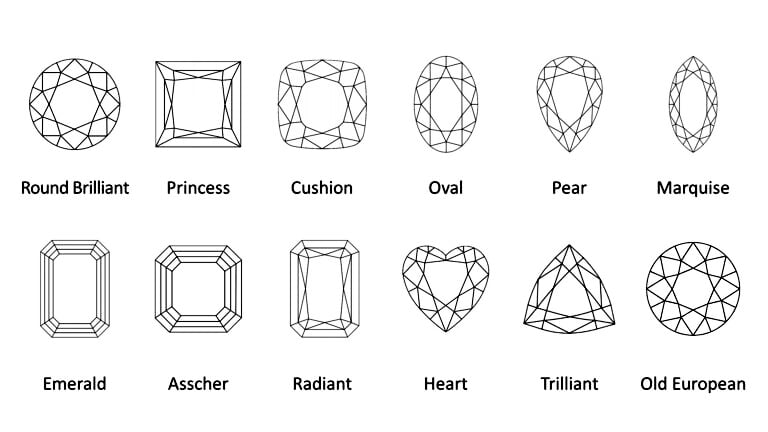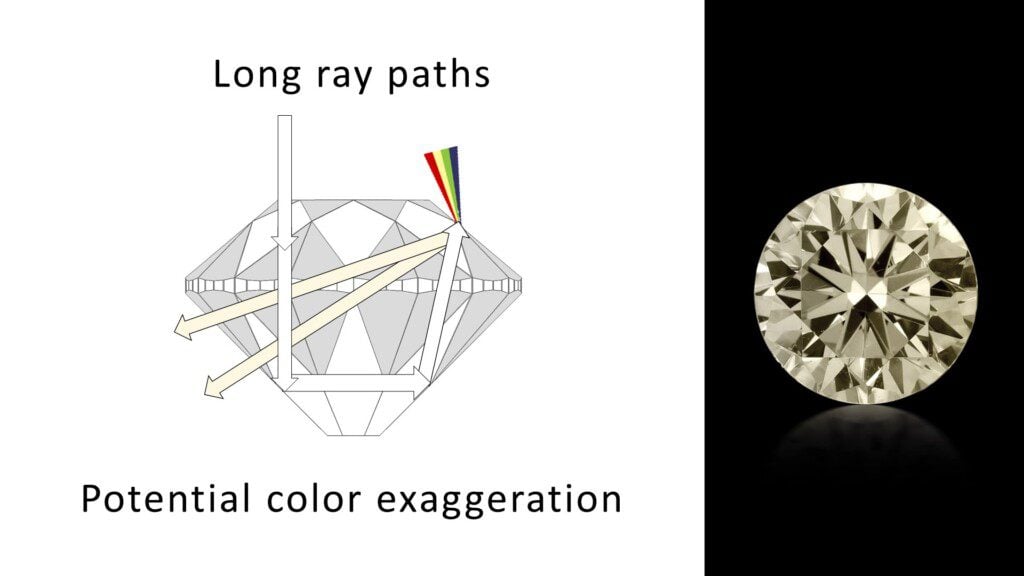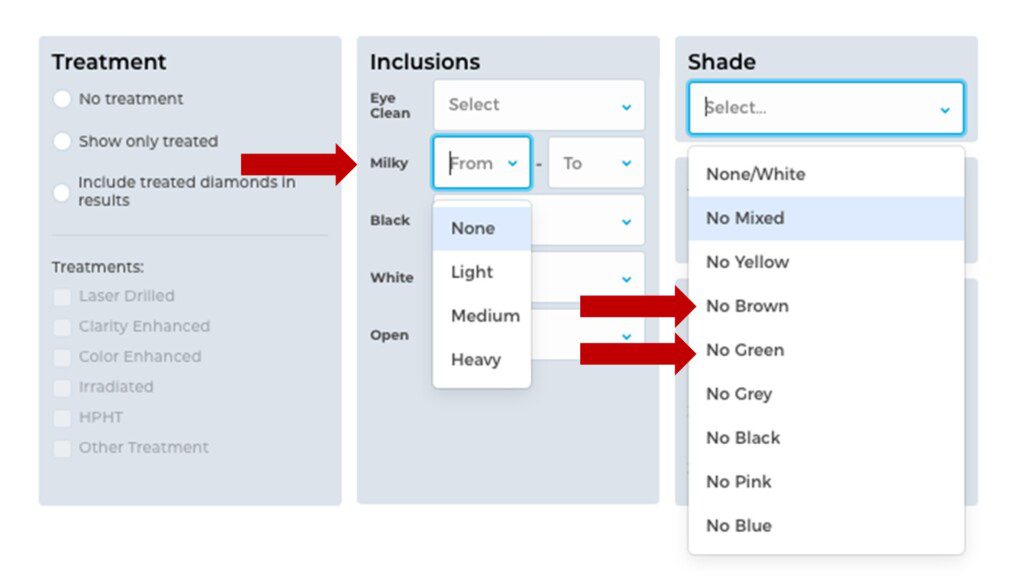How Are Diamonds Made? Natural vs Lab-Created Explained
Two Paths, One Diamond Not all diamonds come from the same place — but they all start the same way. Pure carbon, crystalized under immense pressure and heat. Whether it…
Diamond Color – Basics
Diamond color influences price the most after carat weight, so this page can help you (a) save a lot of money without sacrificing appearance, or (b) justify your desire to spend more on icy white rarity.
Diamond Color Scale

PriceScope Pointer: The most purchased diamond colors are F-G-H or I, set in white gold or platinum. Well-cut round diamonds can “face-up” with better color than their lab grade if extremely well cut.
Before going on: Check out the PriceScope Diamond Buying Guide
A diamond’s color was caused by chemicals in the earth where it formed. Most of the world’s diamonds are yellow or brown. Those diamonds are graded on a scale ranging from D, which has the least color, all the way to Z, which is light yellow or possibly light brown. Other colors, and stronger levels of yellow and brown, are classified as fancy colored diamonds, and are graded on a different scale.
Diamonds graded DEF are considered colorless. GHIJ are near-colorless. Colors K through Z go from faint to very-light and light shades of yellow or brown.
PriceScope Pointer: Top diamond color grades D-E-F are ‘collection colors,’ valued for icy-appearance and rarity.

Expert Guidance: Our vetted vendors include Whiteflash, Blue Nile, and JamesAllen.com - all of whom have experts ready to listen and help you determine which combo of the 4Cs is perfect for you - and nicely in budget. Contact Us and get help today.
Most people cannot detect a difference of 2-3 color grades unless the diamonds are placed next to each other, especially in the colorless (D-E-F) and near-colorless (G-H-I-J) ranges. With that said, taste comes into play. For those who love the icy appearance and rarity of a colorless diamond, the extra spend may be worth it.
PriceScope Pointer: A difference of 2-3 grades is hard to detect unless you hold the diamonds next to each other.
Have you ever gotten one of those huge paint fan samples? A thick fan of literally hundreds of shades which seem like white? When they are right next to each other you can tell that one is bluer/colder and one is a bit warmer and another is much warmer, but really, they are all white. Then you pick one after agonizing over this white or that white and when it’s on the walls people are like: “Oh. You painted again. And it’s still white. Great…” And you say “But, it’s blue-white.” Or “It’s this white now, it used to be that white. It’s TOTALLY different. (Credit to PS member Gypsy for this analogy)

At the top of the D-Z scale, color context is much like that. Shades of white. E is cold. H is warmer and J is warmer, still. But they are all white.
K-L-M colors are categorized as faint yellow. Upon examination, visible tint is detectable, both from the side and in normal viewing. When mounted and worn normally small stones can seem colorless but large diamonds in this range have a noticeable yellow or brown tint.
N-O-P-Q-R colors are categorized as very light yellow. They show a discernible light yellow tint from the side and in normal viewing. As with faint yellow diamonds, larger diamonds have a more noticeable yellow or brown tint.
S-T-U-V-W-X-Y-Z colors are categorized as light yellow. Face-up, face-down, from the side, loose or mounted, they show substantial yellow or brown tint.
Diamonds tinted brown, rather than yellow, are reported to have the corresponding category of brown following the letter grade. For example, a brown diamond that lands at K on the D-Z scale will be described as K – faint brown. A brown diamond that lands at N on the D-Z scale will be described as N – very light brown, etc.
PriceScope Pointer: Depending on origin and gem-quality, some diamonds may be affected by a colored undertone that is not noted on the grading report. Read more about this in our farther down this page: Undisclosed undertone.
If you’re looking to buy loose diamonds online, use our special tools to reveal the best cut quality diamonds! Start your diamond search and choose from over a million loose diamonds for sale. Use our filters to find either natural or lab diamonds, as well as fancy color diamonds.

Most diamonds have either yellow or brown tint, but there are diamonds with colors outside those in the normal D-Z range. This can include pink, blue, green, black, red, and orange diamonds. Diamonds that exhibit these colors are categorized as Fancy Colored Diamonds (FCD) and are graded using different scale and system. Yellow or brown diamonds with more saturation than Z are also categorized as FCD, and are considered to be fancy yellow or fancy brown.
Unlike carat weight, which is standardized, color and clarity grading are subjective human estimations. Moreover, some laboratories have softer standards than others: The diamonds seen in many chain stores, malls, and discount outlets have observable tint at higher grades, unlike diamonds sent to top-tier laboratories. This can give shoppers a false and negative first impression about warmer color.
Avoid false impressions: JamesAllen.com and Blue Nile, are world class diamond sellers with outstanding reputations for quality assurance and diamonds with accurate grades. Avoid chain-store grading by purchasing from our vetted vendors.

Sub-par cut quality can also cause a diamond to show more color face-up than its lab grade, as we will illustrate below. There is an enormous range of appearance for diamonds of any single color grade, based on the variables.
PriceScope Pointer: Take a cut quality shortcut. See our Descriptive Proportions Chart to know whether a round diamond shows more brightness, more fire, or a balance. Our longstanding Member Recommended Proportions are listed there too.
PriceScope’s 1-5 star ratings are categorical comparisons with the most thorough, consumer-focused online diamond and jewelry vendors, in categories, we believe reflect our experienced consumer community’s values. Check out PriceScope Jeweler Reviews.
YES.
Successful online sellers like our recommended PriceScope vendors, have methods of reliably classifying and communicating the quality of a diamond’s cut, whether you’re examining it in person or purchasing online. They also offer liberal inspection periods and free returns so you can make your purchase with complete confidence
1.Start with diamond grading reports: Diamonds over 0.25ct should come with a full report (or certificate) issued by a gemological laboratory. Color and clarity grading is subjective so tolerances among labs vary – even between a single lab’s various locations – but the accepted standard among reputable institutions is +/- one grade.
PriceScope Pointer: GIA, AGS, IGI, and GCAL all grade loose diamonds with strict, reliable standards. Read more about these laboratories on our diamond certification page.
2. Ask for photos and videos: First things first. Camera and monitor settings make diamonds look different screen to screen, so you can’t make nuanced decisions with images. With that said, videos and images are useful. And when a seller’s in-house images are consistently made, in one setup, then head-to-head comparisons within that seller’s inventory are practical.
3. Ask the seller directly: If you have questions beyond what a diamond grading report and supplemental videos and images can communicate, pick up the phone, chat or email and get in touch with the vendor. It’s in their best interest to communicate transparently with you. After all, they don’t want the expense of shipping a diamond, only to have it returned on their dime as well.
The appearance of diamond color in normal viewing may be influenced by factors beyond the basics, starting with colors in the environment, particulars of the color grading process, the weight of the diamond, and the possible presence of unreported undertones.
PriceScope Pointer: Don’t go diamond shopping in a yellow sweater – diamonds reflect back what’s around them.

For these reasons, diamonds are professionally assessed in neutrally-colored environments by graders wearing white tops, seen under diffused light sources with white color temperatures.
You read that correctly. Gemological laboratories perform D to Z color grading with the diamond upside down and viewed through the side. Why through the side? To permit a neutral view. Viewing a diamond from the top is not neutral because of three factors that may influence color appearance in the “face-up” position:

“Face up” is the way we normally view diamonds, looking down on the diamond’s top.
Fancy shapes may reveal more color than round brilliant cuts in the face-up position because they have broader facet arrangements. This is largely a non-factor in diamonds graded DEF. The potential for a more visible color appearance or color concentration increases the more you consider diamonds graded GHIJ and below.
 B. Cut Quality and “Face-Up” Color.
B. Cut Quality and “Face-Up” Color.In well-cut diamonds, the light gets in and out on shorter ray paths with greater intensity. This can cause the appearance of less color when the diamond is seen from the top.

Top cut quality can help diamonds appear more colorless: Cut-focused brands like Whiteflash A CUT ABOVE® have been reported to benefit from face-up color reduction in PriceScope testimonials.
Alternately, if the diamond is cut so that light escapes through the bottom – or bounces around inside – the color within that diamond may be exaggerated when seen from the top.

Diamond fluorescence, present in approximately 30% of diamonds, is caused by trace elements within the crystal structure that emit visible light when excited by ultraviolet light or x-rays. Blue is the most common shade of fluorescence and can theoretically cancel some yellow color in environments with ample sunlight. Diamond fluorescence can, therefore, sometimes make a warmer-colored stone appear more colorless. The effects of fluorescence on color should be judged on a case-by-case basis, as the impact varies from stone to stone.

Fluorescent diamonds trade at a discount so fans of this phenomenon may enjoy more diamonds, potentially facing up with less color than the laboratory grade, for less money. However, the long-term value of diamonds with fluorescence is in question, as certain world markets avoid dealing with them entirely.
As diamonds increase in carat weight the presence of color becomes more noticeable, simply because whatever color exists throughout the diamond occurs takes on more mass. The presence of color in diamonds graded K and below becomes especially noticeable at weights above 2.50 – 3.00 carats.
Are you seeing diamonds that seem inexplicably low-priced? There are a few reasons this might be the case and one of them is a subtle or not-so-subtle brown, grey or green undertone which influences the overall color appearance. Another may have to do with undisclosed clarity issues. The endgame here is to always ask the seller why the diamond is discounted so much, but let’s arm you with some color facts first.
These issues are disclosed among traders. Wholesale suppliers are being asked to declare a diamond has “No BGM” (brown/green/milky) in business-to-business comments, but those notes are not typically passed on from diamond sellers to consumers.

The world’s largest wholesale loose diamond trading platform has now added the ability to include or exclude “milky” diamonds (as a diamond clarity supplement) along with undertones of different shades, including brown, green, and grey (as a diamond color supplement).

The situation is fluid, complicated by assessment thresholds and resistance to disclose, from miner to supplier to retailer to shopper. Much of the wild variability in diamond pricing is attributable to undisclosed elements such as these.
The number of diamonds coming to market with undertone other than yellow has increased as long-standing mines reach their gem-quality limits, and green-tinted rough from Zimbabwe flows into India and China.
1. Revisit our advice above: Can I buy Diamond Color online with confidence?
2. Start with diamond grading reports, look for seller-provided photos and videos, look for standardized imaging and, most importantly, ask the seller directly: If you have questions beyond what a diamond grading report and supplemental videos and images can communicate, pick up the phone, chat or email and get in touch with the vendor. It’s in their best interest to communicate transparently with you. After all, they don’t want the expense of shipping a diamond, only to have it returned on their dime.
Anything in this section can be overruled by personal taste and preference. If your beloved aunt buys a 3.00 carat D color diamond and mounts it in a rich, buttery gold setting – that colorless diamond will take on a colored/tinted appearance, since diamonds absorb and reflect-back the colors in their surroundings.
Honestly, if her heart was set on that rich yellow setting, she could have chosen a 5.00 carat J color instead – since it would have the same end appearance when mounted. We all love our aunts and respect their personal tastes and preferences, but when making your own decisions the tips below are something to be aware of.

There are a lot of preconceived notions about diamond color. These may have to do with where someone grew up and what they learned about diamonds. Whatever the case, it’s a good idea to know how the wearer feels about color and, in some cases, it may be enlightening to share this information with that person.
Many people are under the false impression that diamonds with higher color sparkle better. This is false. A diamond’s observable brightness, fire, sparkle, and contrast are all attributable to its cut quality. Diamonds with identical cut geometry will sparkle identically at any color from D-Z. As color descends from K to Z there is more tint in the body, coupled with spectral absorption dynamics, but the intensity and quality of sparkle are no less at Z color than it is at D.
Collection quality diamonds are those with color and clarity combinations that trade for the highest values and continue to hold that value best over time. Combining a non fluorescent D color, E color, or F color with Flawless, Internally-Flawless, VVS1 or VVS2 clarity gives a diamond collection quality status in the eyes of diamond professionals and enthusiasts. Some people choose high color and clarity combinations for this reason.
Depending on culture and philosophy, diamonds may be seen as reflections of the relationships they symbolize. In such cases higher clarities and colors may be chosen, out of personal preference, to symbolize the perfection and purity of the union.

Get fast answers to any question: Ask our community of unbiased independent helpers.
People also ask
The best color depends on a number of factors which include the wearer’s preferences in terms of carat weight, clarity, and cut. To balance color against the other Cs, especially all-important cut quality, read the PriceScope Diamond Buying Guide.
Check out our Diamond Price Guide to see how different factors impact a 1-carat diamond’s price. We have also included a diamond price calculator for you to see today’s prices in real-time, based on more than 500,000 diamonds listed in our search engine.
This is a great question since top cut quality can positively influence a diamond’s face-up color. Learn how to select a diamond that might face up more colorless than the grade it was given by reading our page on Diamond Cut.

Retail Diamond Prices Chart Updated Monthly.

Two Paths, One Diamond Not all diamonds come from the same place — but they all start the same way. Pure carbon, crystalized under immense pressure and heat. Whether it…
A Wedding Ring as Unique as Your Love Finding the right wedding ring isn’t just about diamonds or gold – it’s about finding the one that feels right. With hundreds…
So, you’re thinking about lab-grown diamonds? Smart move. They’re just as sparkly as the natural kind but usually cost less. But where do you actually go to buy them? It…

Want to stay updated on the most recent blogs, forum posts, and educational articles? Sign up for Bling News, PriceScope’s weekly newsletter.